Growing your own microgreens opens up a world of ways to adding taste and nutrition to your everyday meals as well as creating new meals to your table. When you start growing your microgreens you may be unfamiliar with the many ways that microgreens can be prepared in regular everyday meals to use these nutritious seedlings. Since most of the vegetables grown as microgreens also function as full-grown salad greens, they are easily substituted in many different dishes.
So what are the tastiest ways to use microgreens? Microgreens can be used in many different ways and we have listed some of the ones we find is adding flavor and crunch to an everyday meal:
- Added as pizza toppings
- Incorporated into stir-fries for Asian dishes
- Mixed into rice dishes
- Used on appetizers
- Used with sweet baked goods
- Combined with Vegan and Vegetarian dishes
- Added to Sandwiches, Burgers, and Wraps
- Blended into pesto, salsa, or other pasta sauces
- Tossed together with other vegetables as a salad
These cooking methods and more let you add more microgreens into your diet so that you can not only eat healthier, you can eat food that is more vibrant and flavorful too. We have collected from some great sites, some of what we believe are the tastiest recipes that are incorporating microgreens. Keep reading to get inspired and to learn how you easily can make microgreens part of your daily meals.
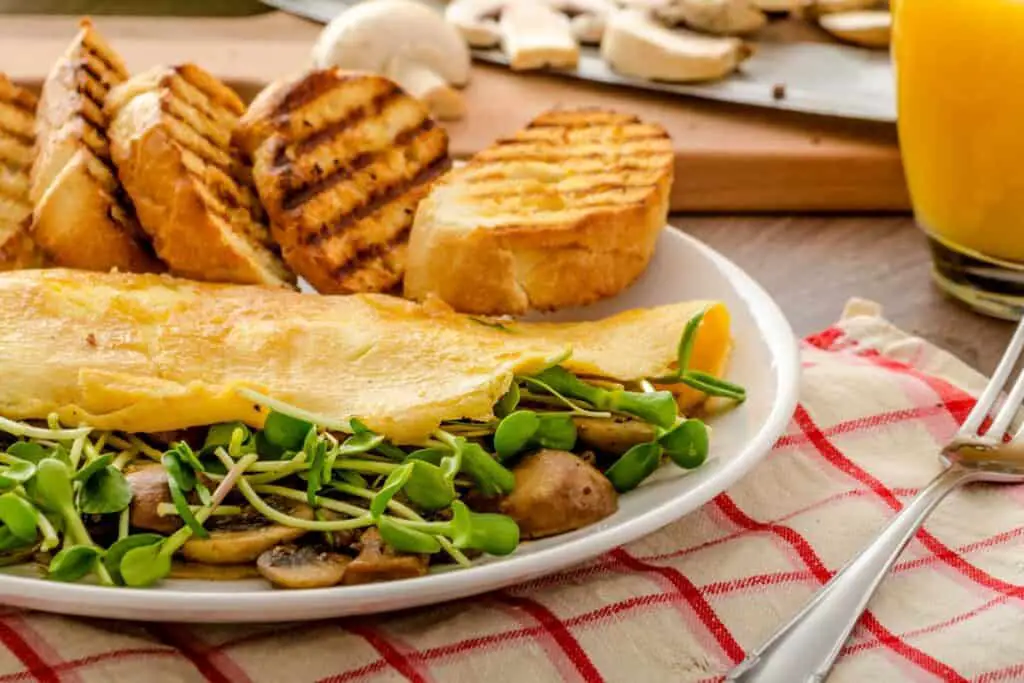
Advantages of Cooking with Microgreens
If you’ve never cooked or grown microgreens before, you’ll probably be surprised at how well microgreens can grow from being a gardening hobby into a culinary one. There are many benefits to growing your own microgreens and adding them into your normal culinary dishes, including the following advantages:
- You’ll be adding tons of nutrients, vitamins, and minerals to your meals. Microgreens are considered a superfood by many dieticians, and with good reason—these little greens are packed full of high-powered nutrition that can help significantly improve the nutritional profile of your daily diet.
- You’ll be making your food look fancier. Microgreens add an aesthetically pleasing pop of vibrant color to any meal and gained prominence in culinary circles as a sophisticated garnish in high-end restaurants. If you want to make your homemade meals more Instagram-worthy, microgreens are a great way to add a little pizzazz.
- Microgreens are a good way to eat sustainably. For those who are in urban environments or don’t have space at home to grow a full vegetable garden, microgreens can be a great way to incorporate more homegrown vegetables without needing an entire yard to do it. Most microgreens can be easily grown on a kitchen counter or in a sunny windowsill.
- Microgreens can be grown as a culinary side hustle. For those willing to dedicate the space to them, microgreens can be grown in quantities that are large enough to sell for culinary purposes as well as to cook with. Since microgreens are not very shelf-stable, local chefs often source microgreens through private growers rather than grocery distribution chains.
No matter if you’re growing them for your own cooking use or growing them for someone else to cook with, microgreens can bring normal meals up to another level.
RELATED: The 14 Most Nutritious Microgreens to Grow and Eat
35 Tasty Recipes Using Microgreens
If you’ve ever wanted to grow microgreens but you wonder how you could use them all without just dumping them in a salad mix, we’ve got you covered. We have collected 35 of what we find are the best microgreen recipes. Sometimes some inspiration sparks a new approach to healthy living.
Note that the microgreens used in these recipes are just suggestions. In most cases, you can easily substitute microgreens of your choice for whichever microgreens are listed in the recipe if there is a type of microgreen included that you don’t like or aren’t growing. Because most microgreens have a mellow flavor, they can be easily substituted for each other without having a major impact on the overall flavor of the dish.
Microgreens on Pizza
Especially in high-end pizzerias, microgreens have found a complimentary home on many different varieties of pizza. Since greens naturally pair well with yeasty bread and cheese, they are a perfect companion for pizza.
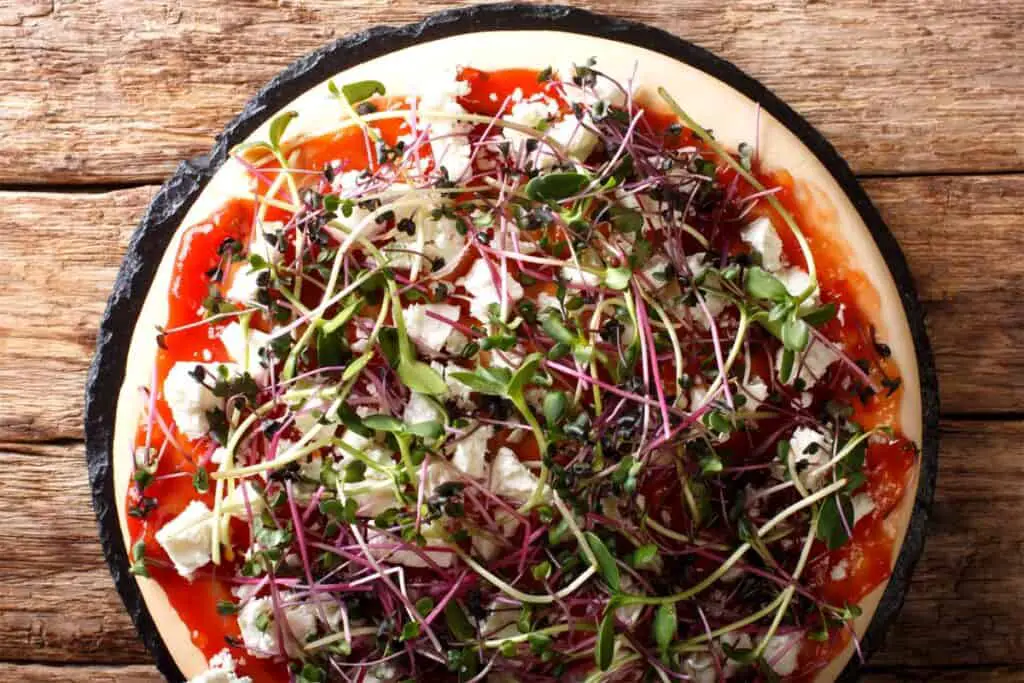
Here are some of the best microgreen pizza recipes:
- Peach Ricotta Pizza with Spicy Microgreens: This pizza recipe combines mild but tangy ricotta cheese with peach as a traditional taste pairing but also throws in spicy-flavored microgreens as a topping and a finishing balsamic drizzle to bring out the naturally complex flavors.
- Pizza with Pesto, Mozzarella, and Arugula Microgreens: This verdant pizza has more traditional pizza flavors with pesto and mozzarella but also throws in a peppery note through the use of fresh arugula microgreens.
- Pesto Pizza with Burrata, Prosciutto, and Microgreens: This is another pizza that incorporates both pesto and microgreens, but in this version pairs them with salty authentic Italian burrata cheese and prosciutto to provide a rich counterbalance to the earthy pesto.
- Beet Pizza with Spicy Feta and Microgreens: This vegetarian pizza mate tangy goat’s cheese with beets in a traditional food pairing that is perfectly complemented by microgreens. When added as a fresh topping, the microgreens also add a pop of bright green to the dark purple color of the beets and the bright white feta for a festive-looking dish.
- Ricotta and Asparagus Pizza with Microgreens: This is another great pizza for using up spring produce that features asparagus as its main vegetable. Together with microgreens and creamy ricotta cheese, asparagus packs a lot of vitamins and minerals while managing to be tasty, too.
- Strawberry Pizza with Microgreens & Goat’s Cheese: Cheese and fruit topped pizzas are a popular choice for adding microgreens as a garnish since many are either only mildly flavored or have a sweet flavor that complements fruits and soft white fresh cheeses like ricotta, burrata, mozzarella, and feta.
While many of the pizza recipes that use microgreens skew towards the vegetarian side of the pizzeria, any meat-based pizza can also be amped up through a liberal dose of cut microgreens used fresh-cut and sprinkled on top of a pizza right out of the oven. Microgreens are also a good way to incorporate some freshness and crunch to cold pizza the next day, too.
Because microgreens pair well with most fresh cheeses and vegetables, they are easy to substitute in or add onto most pizza varieties as a topping without detracting from the pizza’s overall presentation or flavor. If anything, they are a surefire way to enhance the final dish when used correctly.
Microgreens in Asian Cuisine
One type of cuisine where microgreens are often found either as an incorporated vegetable or a garnish is in Asian cuisines, where microgreens are valued for their texture and vibrant color in fresh dishes. Whether chopped up on top of sushi, sprinkled over noodles or rolled into spring rolls, microgreens are a great contemporary addition to many different traditional Asian meals.
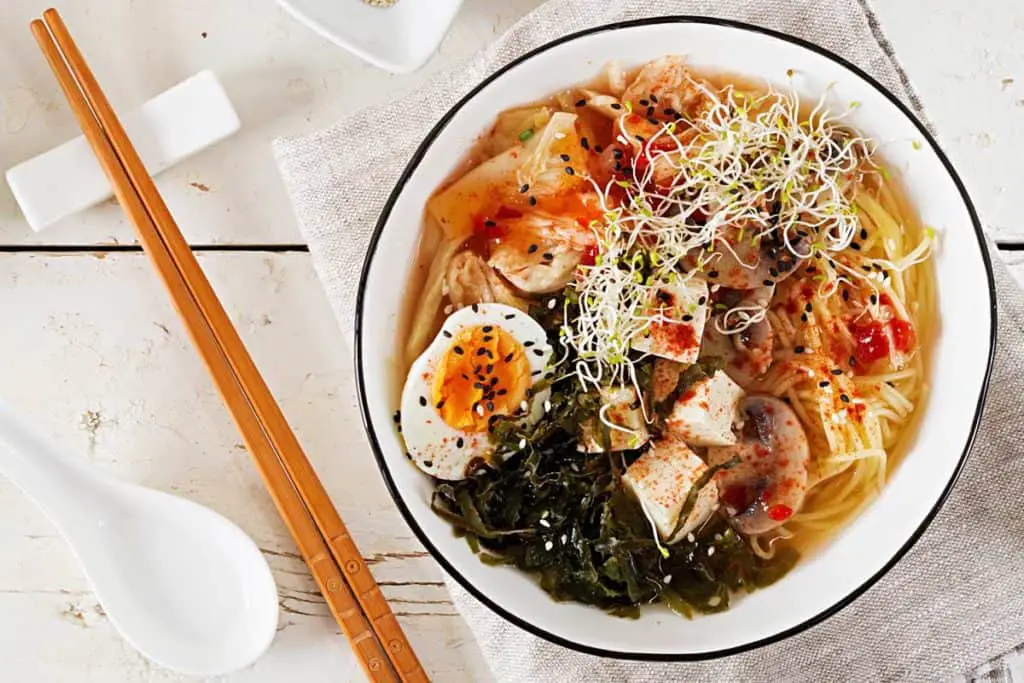
- Vegan Sushi: There isn’t much cleaner eating out there than vegan sushi, but these filling rolls stuffed with tofu and microgreens will convert even the pickiest eater. Rice vinegar, julienned carrots, avocado, and toasted sesame seeds give these vegan, gluten-free rolls authentic Japanese flavor.
- Rainbow Spring Rolls: Rainbow spring rolls use brightly colored radish microgreens to add some spicy crunch to these vibrant vegetarian spring rolls. These rolls also add in other high-nutrient ingredients like quinoa, beets, and basil.
- Kobe Beef and Prawn Udon Soup with Asian Microgreens: This dish is a little heavier on the meat and noodles than most of the Asian recipes selected for this list, but the expense of the prawns and Kobe beef is well worth the splurge.
Many standard Asian recipes favor fresh or fresh-pickled vegetables as a garnish or family-style condiment alongside roasted meats and soups, so there are plenty of opportunities to incorporate microgreens into Thai, Chinese, Japanese, and other Asian culinary traditions.
Microgreens in Rice Dishes
When used in rice dishes, microgreens can be either cooked into the rice like a vegetable or can be added as a cold garnish on top so that it retains its texture without wilting. Because microgreens come in a variety of different flavors, multiple varieties are suitable for adding into rice to enhance its nutritional value as a side dish.
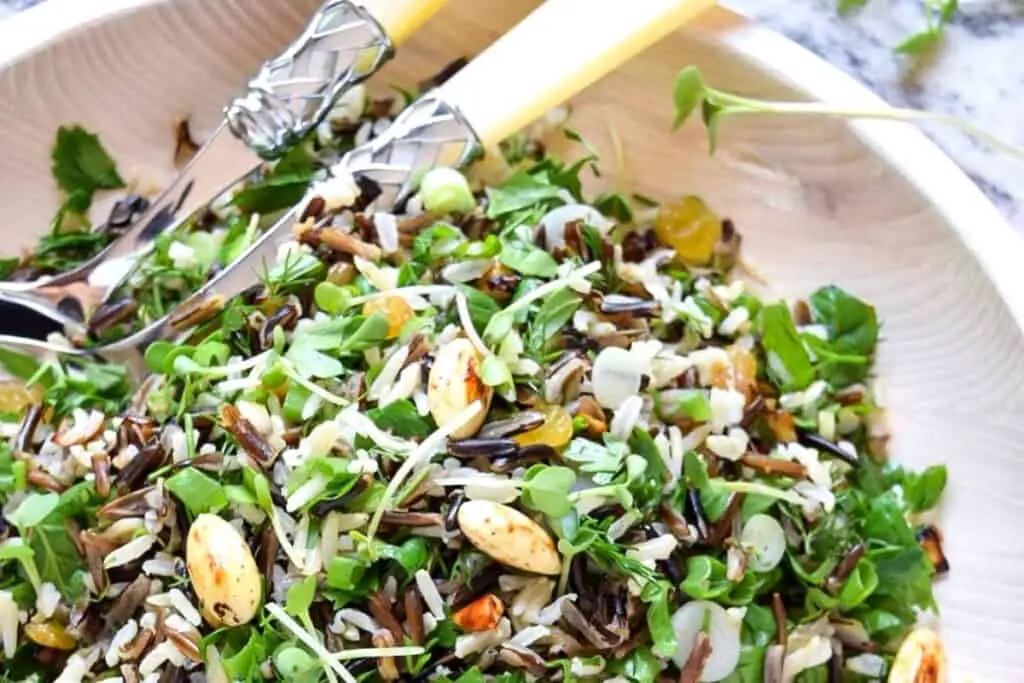
- Green Garlic Risotto with Spring Vegetables: This creamy, savory rice dish is a perfect way to use up farmer’s market loot or your own backyard vegetables along with some homegrown microgreens. This fresh rice dish makes for a filling side or even a light lunch or supper if paired with some bread and salad.
- Wild Rice and Microgreen Salad: Wild and brown rice are considered healthier alternatives to white rice due to the higher fiber content, but this wild rice dish also includes several other healthy ingredients including golden raisins, red onion, microgreens and several types of chopped fresh herbs.
Microgreens can be added into several varieties of rice dishes post-cooking or can be served on top of rice as an edible garnish to make sure that a serving of healthy vegetables ends up eaten along with the rice. When cooked into rice and casserole dishes microgreens can take the place of other cooked greens such as kale or spinach—when served chilled as a garnish on top of a hot rice dish, they offer an interesting contrast in texture and temperature.
Microgreens in Appetizers
Since microgreens found their early popularity in high-end restaurants, it’s easy to see how they have continued to see a lot of use in fancy appetizers. Even if you’re just making some quick finger foods for a ball game, adding microgreens as a garnish can help sneak a few more healthy greens into your family’s overall diet.
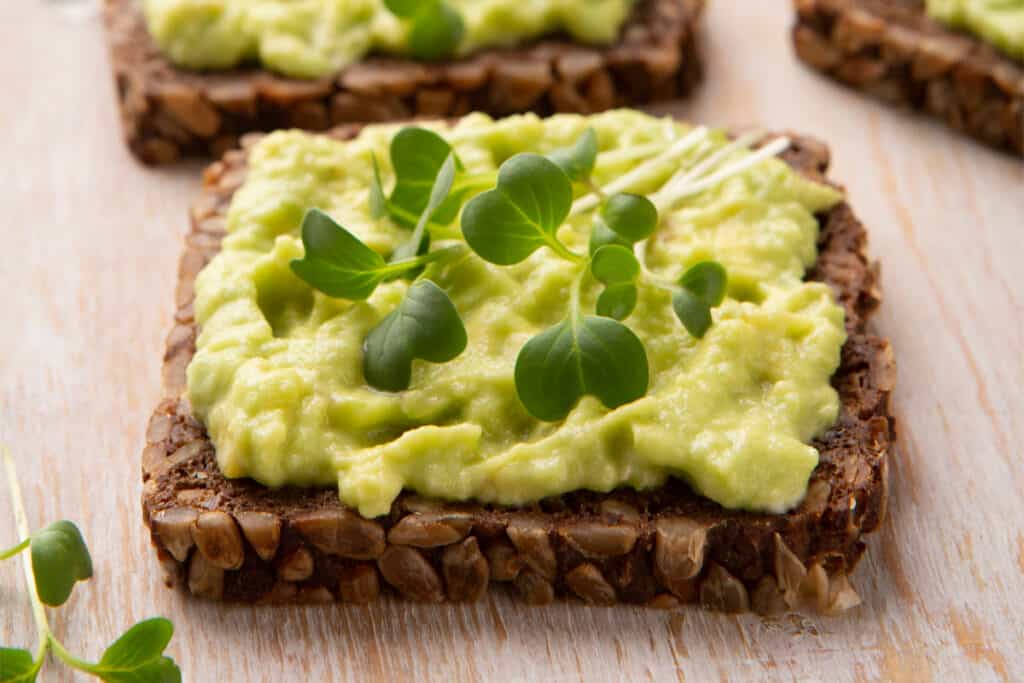
- Tomato Avocado Toast: Sprouts and microgreens came to prominence early in culinary trends as a flashy garnish on bruschetta and other open-faced plates. Microgreens offer lots of crunchy texture to contrast with the creamy avocado and juicy tomato slices in this classic appetizer.
- Radish Puff Appetizer: These radish puffs filled with rich goat cheese, radishes and microgreens as topping serves as a great appetizer to any party! With their tasteful buttery crunch and beautiful garnish, they are guaranteed success.
- Goat Cheese Bacon Crostini and Microgreens: Microgreens help cut the rich flavors of bacon and cheese in these open-faced bite-sized appetizers. Any kind of microgreen could be used, but arugula is an especially good pairing with both bacon and goat cheese.
- Carrot Tartare with Microgreens: If you’re looking for an appetizer that is a little fancier, this carrot tartare is perfect as a vegetarian appetizer for a dinner party or a sophisticated, romantic meal for two.
Especially for holidays that favor green as a major color, such as Christmas and St. Patrick’s Day, microgreens can act as a perfect accent for themed party appetizers. Microgreens are also a choice to help cut the rich flavors of heavier appetizers and act as a palate cleanser between richer courses.
Microgreens and Baked Goods
In both baked desserts and savory baked goods, microgreens can act as a bright grassy note of flavor against more cloying flavors such as cheese and fruit. Since these tarts are just as good served room temperature or chilled as they are served warm, this can help preserve the integrity of the microgreens by avoiding heating them to the point of wilting.
- Spring Asparagus Tart with Feta and Microgreens: This rich tart signifies nothing but the arrival of spring! With a combination of feta, lemon, and asparagus this makes tart from heaven. With a drizzle of tzatziki and microgreens on top, you’ll end up with a delicious result and a taste of the Meditteranean.
- Microgreen, Zucchini, and Carrot Cake: This spiced loaf cake may take some flavor cues from less healthy versions, but this carrot cake is a great way to sneak in some extra nutrition in the form of zucchini and microgreens into an otherwise rich dessert. These cakes also freeze well to thaw and eat later if you need a way to put up vegetables from the garden.
- Mini Strawberry Chocolate Tarts with Whipped Goat’s Cheese and Basil Microgreens: Picking aromatic herbs like basil early not only helps preserve some of their vibrant early colors as seedlings, it also helps mute and mellow their herbal flavors to make them a better pairing for sweet dishes like these baked strawberry tarts.
- Spring Lemon Tart with Brown Butter Shell and Lemon Basil Microgreens: While some less experienced cooks might not think of basil and lemon as natural allies on the palate, these two spring flavors go surprisingly well together.
Since herbs can be grown as microgreens as easily as other vegetables, these aromatic garnishes (especially basil and mint) are a nice mellow accent for desserts to help cut through their sugar and fat, showing that microgreens have a versatility beyond meat-and-cheese based dishes.
Microgreens in Vegan and Vegetarian Dishes
Microgreens have gained lots of favor in vegetarian and vegan circles for their ability to add a dazzling array of colors and textures into what are sometimes unfairly dismissed by many non-vegetarians as bland or visually unappealing dishes. With the addition of tasty microgreens and some satisfying meat alternatives, vegetarian dishes never looked so good.
- Green Goddess Revitalization Bowl with Herbed Buckwheat, Avocado, and Microgreens: If you’re wanting to try something a little different for your breakfast or lunch, these veggie bowls packed with warm buckwheat, silky avocado, and microgreens are satisfying as well as nutritious.
- Vegetarian BBQ Tempeh Burgers: If you’re looking to add more vegetarian entrees into your weekly meal rotation, you could do a lot worse than these BBQ tempeh burgers dressed with cheese, caramelized onions, and microgreens. If you’re not looking to make your own tempeh, it can be found in most grocery stores wherever the tofu and other meat alternatives are kept.
- Mushroom and Microgreen Omelet: Leafy greens are a classic choice to combine with eggs in fancy dishes such as quiche, so this microgreen-and-mushroom omelet is a good way to sneak some savory vegetables into an otherwise protein-packed breakfast.
- Stir-fried Pea Shoots: This fried Chinese vegetable dish is simplicity itself—nothing but fresh pea shoots, freshly grated ginger, and oil for frying. When cooking in a wok, the key to avoiding soggy vegetables is to get the temperature of the wok high and the oil very hot (almost smoking) before adding anything to cook.
Part of the challenge of following a vegetarian or vegan diet is making sure that you incorporate a wide variety of fruits, vegetables, grains, and vegetable-based protein into your diet while also fixing meals that the whole family will enjoy. Microgreens help keep vegetarian options fresh and make sure that whoever eats them stays well-nourished in the process of learning how to eat meat-free.
Microgreens in Sandwiches, Burgers, and Wraps
Sandwiches, burgers, and wraps have been some of the go-to dishes to include microgreens in since they skyrocketed onto the culinary scene several years ago. Whether taking the place of lettuce or acting as a high-class garnish on the side, microgreens are the perfect way to level up your lunch.
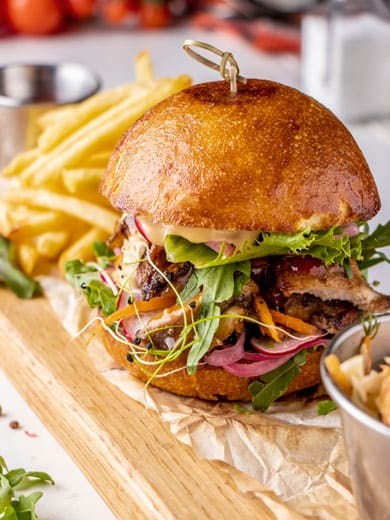
- California Quinoa Burger with Microgreens: This vegetarian burger is so savory and filling you won’t even miss the meat. Microgreens and other crunchy condiments act as a nice textural balance to the soft chew of the burger filling and the bun.
- Power Veggie Sandwich: This traditional sandwich pairs up red bell pepper, avocado, microgreens, and other vegetables with roasted garlic hummus and whole-grain bread. There are so many vegetables on this vegetarian entrée it is just as satisfying as a sandwich with deli meat and is designed to give you all the nutrition you need to power through a long, tough day.
- Open-Faced Veggie Sandwich with Microgreens: Microgreens are often used in open-faced sandwiches since their fluffy, grassy texture is a visual delight that begs to be left uncovered by a top bun. This basic vegetarian sandwich is a combination of hummus, carrots, avocado, goat cheese, and microgreens on whole grain bread.
- Super Greens Sandwich: These super healthy sandwiches featuring kale microgreens, chopped spinach, and cucumbers are a great choice for a healthy lunch option. A creamy avocado sauce with lemon juice and olive oil helps tie everything together.
- Turkey, Cheese, and Avocado with Greens Sandwich: This sandwich has a classic pairing of turkey and cheese made verdant with additions of green pesto, avocado, and microgreens. Using ciabatta bread makes this light sandwich feel indulgent. Using pepper jack cheese rather than milder provolone or swiss gives the whole proceedings some kick too.
- Salmon Sandwich with Microgreens: Salmon (both fresh and smoked) has been traditionally paired with leafy greens for centuries—this sandwich continues the tradition by adding pea greens and rainbow microgreens along with other vegetables such as tomato and cucumber.
The milder microgreens, such as sunflower seedlings, can be easily added to most sandwiches and wraps regardless of other flavors present. By using microgreens instead of a traditional leaf or shredded iceberg lettuce, you can add some vegetables to your sandwich with more nutrition and flavor than iceberg lettuce provides.
Microgreens in Salads
Using microgreens in salads (either as an addition to traditional salad greens or in place of them) is one of the most steadfast methods of preparing microgreens in a flavorful way. With just a dash of homemade vinaigrette or in combination with ingredients such as goat’s cheese and fresh produce, microgreens help bring salads into a league of their own.
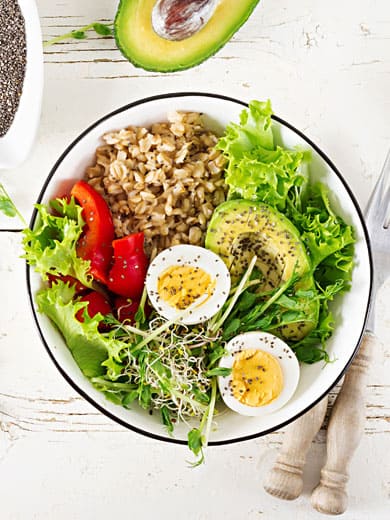
- Warm Beet Salad with Microgreens, Bacon, and Goat Cheese: This warm salad features a complex play of flavors between the earthy beets, oily bacon, salty cheese, and crunchy greens. Bright green microgreens are often featured alongside beets to help play up their deep red coloring.
- Red Quinoa Salad with Radishes, Microgreens, and Pickled Hatch Chiles: This grain-based salad might have some more exotic ingredients than your usual workday lunchbox, but they are well worth the pick-up. Red quinoa and radishes provide plenty of texture and crunch while microgreens add leafy goodness and pickled chiles provide bites of savory warmth.
- Sugar Snap Peas and Pea Microgreens with Ginger-Curry Vinaigrette: This recipe takes spring peas two ways and amplifies their mellow flavor with a bright, tangy curry dressing. The main curry flavor of the vinaigrette is accented with fiery ginger and hot notes of cayenne pepper.
- Lemon Dressing and Microgreens Salad: This simple salad with a homemade lemon vinaigrette is created by combining fresh sunflower seedlings with tiny grape tomatoes for a burst of bright flavor in every forkful.
- Shaved Radish, Carrot, Cucumber Salad with Tangerines and Microgreens: While this sweet and bitter salad can be a little finicky to put together, the result is an extremely impressive addition to any dinner party or even just to jazz up a weeknight meal.
- Zucchini, Quinoa, and Microgreens Salad: Zucchini is one of those vegetables that everyone ends up not knowing what to do with when it comes in for the summer in backyard gardens, so this salad is a great way to help use up some of the excesses. Squares of fresh cheese and microgreens help enhance the mild flavor of the squash.
If you’re trying to add more vegetable diversity into your diet and you’re tired of the same old romaine and berg lettuces, microgreens can give you a much-needed reprieve from the same old salad and make eating your leafy greens fun again.
RELATED: Can You Eat Too Many Microgreens?
Tips for Serving Microgreens
Microgreens can be incorporated in many different kinds of meals, but there are a few tips in preparing and harvesting them that can help you serve them at their highest level of quality. Here are some methods you can use to get the most out of your microgreens while cooking:
If you’re using microgreens as a cold garnish on a hot dish, be sure to add them at the last moment before serving to keep the greens from wilting as much as possible from the heat of the dish. A better option can be to serve microgreens on appetizers or meals that are served at room temperature or cold to avoid wilting.
If adding microgreens to a hot dish such as a soup or casserole, add microgreens towards the end of preparation and try not to stir them too roughly when incorporating them into dishes. Some microgreens are more durable than others when being included in a cooked dish, so experiment with several varieties to find the best one for what you’re making.
After harvesting microgreens, avoid washing them until just before serving, since getting microgreens wet in storage can significantly shorten their already short shelf life. Instead, microgreens should be packed dry and then rinsed thoroughly before use. This is especially important if microgreens were grown in soil rather than in a hydroponic system.
Because microgreens are so delicate, growing them at home for culinary use is often the best option for incorporating them into your cooking. While you can sometimes find good microgreens available at farmer’s markets, the ease of growing them means you can save a lot of money by just setting up a few trays for yourself.
A major advantage of cooking with microgreens is that these greens are grown easily throughout the year in an indoor setting, so by growing them, you can enjoy fresh vegetables in your meals even in the dead of winter.
Microgreens Are A Tasty Addition to Many Different Meals
Whether you’re using them as the main ingredient or just as a flashy garnish, microgreens can add some visual and nutritional punch to a wide variety of foods. If you’re looking for some new ways to spice up your garden vegetables or just trying to incorporate more leafy green stuff into your diet, they’re a perfect choice due to their versatility and diversity.




Great compilation of recipes…thank you!